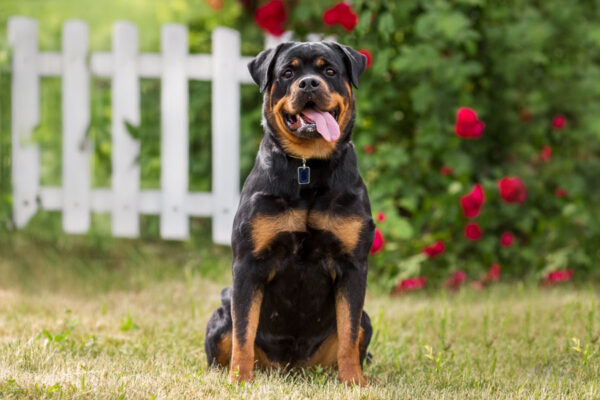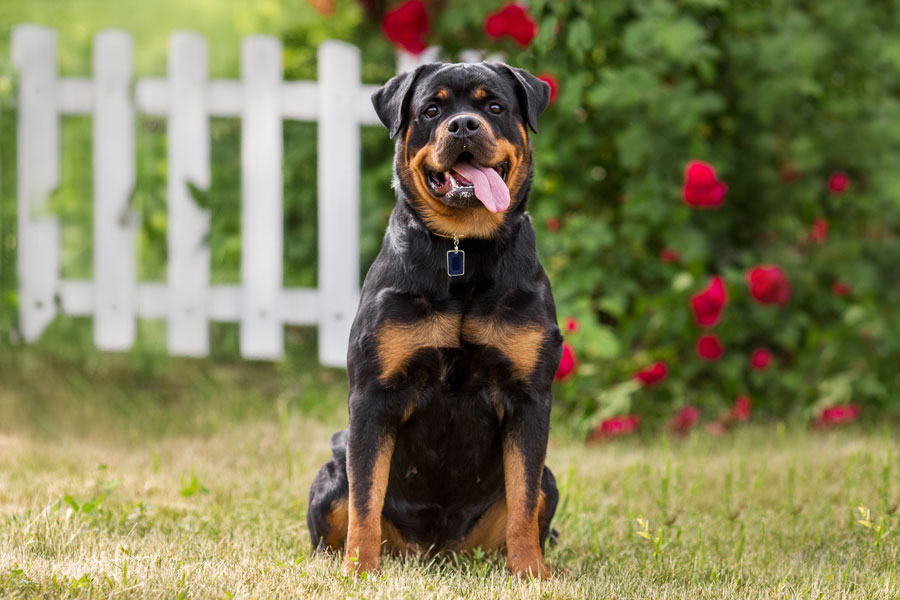Rottweiler – The Confident Protector and Loyal Companion
Rottweilers are a breed synonymous with strength, intelligence, and unwavering loyalty. Known for their imposing presence and protective instincts, Rottweilers have served a variety of roles—from guarding and herding to serving in police and military capacities. This comprehensive article delves into the breed’s history, detailed physical characteristics (including size, weight, and life expectancy), temperament, care guidelines, and common health considerations.

1. History and Origins
Originating in Germany, the Rottweiler descends from ancient Roman drover dogs. They were originally used to herd livestock and pull carts laden with butchered meat to market. Their strength, endurance, and keen sense of loyalty quickly made them indispensable working dogs. Over time, selective breeding enhanced their guarding abilities and overall work ethic, transforming them into the formidable and confident protectors we recognize today.
During the early 20th century, Rottweilers began to gain popularity as police and military dogs due to their intelligence and trainability. Today, they continue to serve in various capacities, from security and search and rescue operations to being loving family companions when properly trained and socialized.
2. Physical Characteristics, Size, and Lifespan
Rottweilers are large, muscular dogs built for power and stamina. Their imposing stature is matched by their balanced proportions and well-defined features.
Key Physical Features:
- Head and Face: Rottweilers have a broad, powerful head with a strong, square muzzle. Their intense, focused eyes exude intelligence and determination.
- Coat: They boast a short, dense double coat that lies close to the body. Typically, their coat is black with clearly defined rust-colored markings on the cheeks, muzzle, chest, and legs.
- Body Structure: With a robust, compact frame, Rottweilers are built for endurance. Their muscular build and deep chest support their agility and physical strength, essential traits for their traditional working roles.
Detailed Measurements:
- Height: Rottweilers typically stand between 22 to 27 inches (56 to 69 cm) at the shoulder, with males generally at the upper end of the range.
- Weight: They generally weigh between 80 to 135 pounds (36 to 61 kg), depending on factors such as gender, genetics, and overall build.
- Life Expectancy: With proper care and a healthy lifestyle, Rottweilers have a life expectancy of approximately 8 to 10 years.
These physical characteristics not only contribute to the Rottweiler’s striking appearance but also enable them to excel in demanding roles that require strength, agility, and endurance.
3. Personality and Temperament
Rottweilers are known for their balanced temperament—a blend of confidence, protectiveness, and loyalty. Their personality traits include:
- Protective and Loyal: Rottweilers are renowned for their natural guarding instincts. They form deep bonds with their families and are exceptionally loyal, making them excellent protectors.
- Intelligent and Trainable: With a high level of intelligence and an eagerness to work, Rottweilers respond well to structured training and positive reinforcement methods. Their ability to learn complex tasks makes them ideal for specialized roles.
- Confident and Assertive: Their confident demeanor is evident in their posture and behavior. Rottweilers are assertive by nature, which can be an asset when properly channeled through training and socialization.
- Calm and Steady: Despite their imposing appearance, well-trained Rottweilers can be calm and composed, especially in a familiar home environment. They require consistent guidance to ensure that their natural assertiveness does not turn into aggression.
Their temperament makes Rottweilers a superb choice for families that can provide firm, loving leadership and plenty of socialization from an early age.
4. Care and Training
4.1. Nutrition and Feeding
Providing a balanced diet is crucial for maintaining a Rottweiler’s health and physical condition:
- High-Quality Diet: Choose premium dog food formulated for large breeds, rich in high-quality protein, healthy fats, and essential vitamins and minerals.
- Portion Control: Due to their size, Rottweilers require carefully measured portions to avoid overfeeding and obesity. Adjust portions according to activity level, age, and metabolism.
- Feeding Schedule: Establish a consistent feeding routine with regular meals to support stable energy levels and proper digestion.
4.2. Exercise and Physical Activity
Rottweilers are energetic dogs that require ample exercise to maintain their muscle tone and mental alertness:
- Daily Exercise: Engage them in at least 60 minutes of moderate to vigorous exercise daily. Activities such as brisk walks, jogging, and interactive play are ideal.
- Mental Stimulation: In addition to physical exercise, mental challenges—such as obedience training and puzzle games—can help keep their intelligent minds sharp.
- Safe Space: Ensure exercise is performed in a safe, secure environment. Due to their protective nature, they benefit from regular social interactions under controlled circumstances.
4.3. Training and Socialization
Early and consistent training is essential for a well-adjusted Rottweiler:
- Positive Reinforcement: Use rewards such as treats, praise, and play to reinforce good behavior. Avoid harsh corrections to maintain their trust and respect.
- Socialization: Expose Rottweilers to various people, environments, and other animals from a young age. This exposure helps them develop into well-rounded adults capable of distinguishing between friendly and threatening situations.
- Obedience Classes: Professional training can further hone their natural abilities and ensure they remain responsive to commands, which is crucial for their role as both guardians and companions.
5. Health Considerations
While Rottweilers are generally robust, they are susceptible to specific health issues. Preventive care and regular veterinary visits are critical:
- Joint Problems: Large breeds like Rottweilers may develop hip and elbow dysplasia. Maintaining a healthy weight and providing joint supplements can help reduce the risk.
- Heart Conditions: Routine cardiovascular screenings are advisable to detect potential heart issues early.
- Obesity: Monitoring their diet and exercise is essential, as obesity can exacerbate joint and heart problems.
- Cancer: Some Rottweilers have a predisposition to certain cancers. Early detection through regular veterinary check-ups is key to effective management.
A proactive approach—including balanced nutrition, regular exercise, consistent training, and routine veterinary care—ensures that your Rottweiler leads a healthy, active life.
6. The Role of the Rottweiler in Society
Rottweilers have carved out a unique niche in both working and family environments:
- Guardians and Protectors: Their natural instincts make them excellent guard dogs, protecting homes and families with vigilance and determination.
- Working Partners: Rottweilers are often employed in roles such as search and rescue, police work, and service tasks due to their intelligence and physical prowess.
- Family Companions: With proper socialization and training, Rottweilers can be affectionate and loyal family pets, offering companionship and security.
- Competitive Sports: Their athletic abilities make them strong contenders in obedience and protection sports, where disciplined training is showcased.
Their versatility and steadfast commitment to their roles in society highlight the breed’s exceptional balance of strength, intelligence, and loyalty.
7. Conclusion
The Rottweiler is a breed that perfectly combines power, intelligence, and loyalty. With a rich history as working dogs and guardians, their impressive physical characteristics—detailed in height, weight, and life expectancy—complement their confident and protective temperament. Rottweilers are best suited for families or individuals who can provide firm, loving leadership and plenty of socialization from an early age.
If you’re looking for a dog that is both a capable working partner and a devoted family companion, the Rottweiler is an excellent choice. With proper care, structured training, and regular exercise, this remarkable breed can bring strength, security, and a deep sense of loyalty to your home.


